Samsonite International Bundle
How did a trunk maker become a global travel giant?
Samsonite International's story is a compelling narrative of innovation and resilience within the travel industry. Founded in 1910 in Denver, Colorado, as Shwayder Trunk Manufacturing Company, the company initially focused on crafting durable luggage for a world where travel was a challenging endeavor. Today, it's a leading Samsonite International SWOT Analysis showcases its current market position.
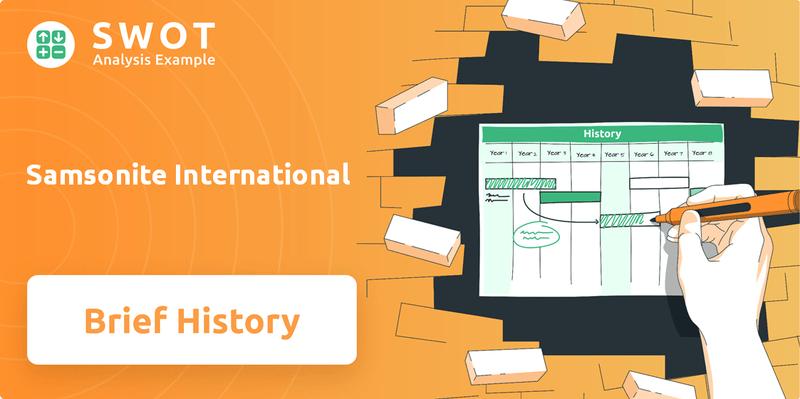
This brief history explores the key milestones of the Samsonite history, from its early years to its global expansion. We'll examine how this iconic suitcase brand adapted to changing travel trends, its strategic acquisitions, and its impact on the travel industry. Understanding the Samsonite company timeline reveals a journey of continuous product innovation and market leadership.
What is the Samsonite International Founding Story?
The brief history of Samsonite International begins in the early 20th century. It's a story of innovation and resilience in the travel industry. The company's roots are firmly planted in a commitment to durability and quality.
Founded on March 10, 1910, by Jesse Shwayder, the Shwayder Trunk Manufacturing Company in Denver, Colorado, marked the start of what would become a global leader. Shwayder, a man of faith, chose the name 'Samson' for one of his early trunks, symbolizing strength. This choice reflected his vision of creating luggage that could withstand the rigors of travel.
The initial focus was on crafting robust, heavy-duty wooden trunks. This was a direct response to the poor quality of luggage available at the time. Shwayder's early funding likely came from his personal resources and close contacts, a common practice for entrepreneurs in that era. The growing travel industry provided a perfect environment for Shwayder's business to flourish.
The company's early focus was on creating strong and reliable luggage. The name 'Samson' was chosen to represent strength and durability.
- The company started as Shwayder Trunk Manufacturing Company.
- The business model centered on high-quality, heavy-duty wooden trunks.
- The company's founding was influenced by the rising travel demands of the time.
- Shwayder's initial funding came from personal resources and close contacts.
Samsonite International SWOT Analysis
- Complete SWOT Breakdown
- Fully Customizable
- Editable in Excel & Word
- Professional Formatting
- Investor-Ready Format
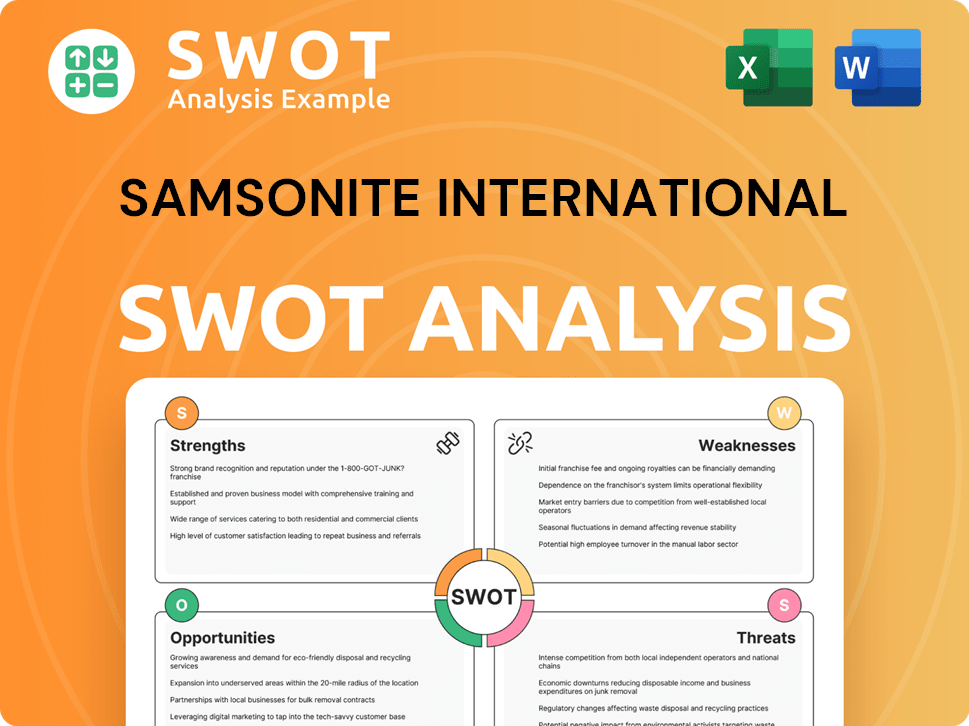
What Drove the Early Growth of Samsonite International?
The early growth of the Shwayder Trunk Manufacturing Company, the precursor to Samsonite International, was marked by a focus on durable products. The introduction of the 'Samson' suitcase in 1916 was a pivotal moment, later influencing the company's name. By the 1930s, the company broadened its manufacturing capabilities and product offerings, adapting to changing consumer needs within the travel industry.
The shift from heavy wooden trunks to lighter, more portable luggage options was a significant innovation. This move was crucial in attracting a broader customer base and staying relevant in a changing market. This innovation also helped the company to adapt to the increased travel demands after World War II.
The post-World War II era saw a boom in travel, which significantly boosted the company's growth. This period was characterized by the company's expansion into international markets. This strategic move helped the company to establish a global presence and increase its market share.
Leadership transitions within the Shwayder family played a key role in guiding the company through its early expansion. The ability to adapt to evolving consumer preferences and a more competitive landscape was essential. This adaptability ensured the company's continued success and relevance.
The company's early expansion involved establishing a presence in various international markets. This strategic move allowed the company to diversify its revenue streams and reduce its dependence on any single market. This expansion was a key factor in its long-term success.
Samsonite International PESTLE Analysis
- Covers All 6 PESTLE Categories
- No Research Needed – Save Hours of Work
- Built by Experts, Trusted by Consultants
- Instant Download, Ready to Use
- 100% Editable, Fully Customizable
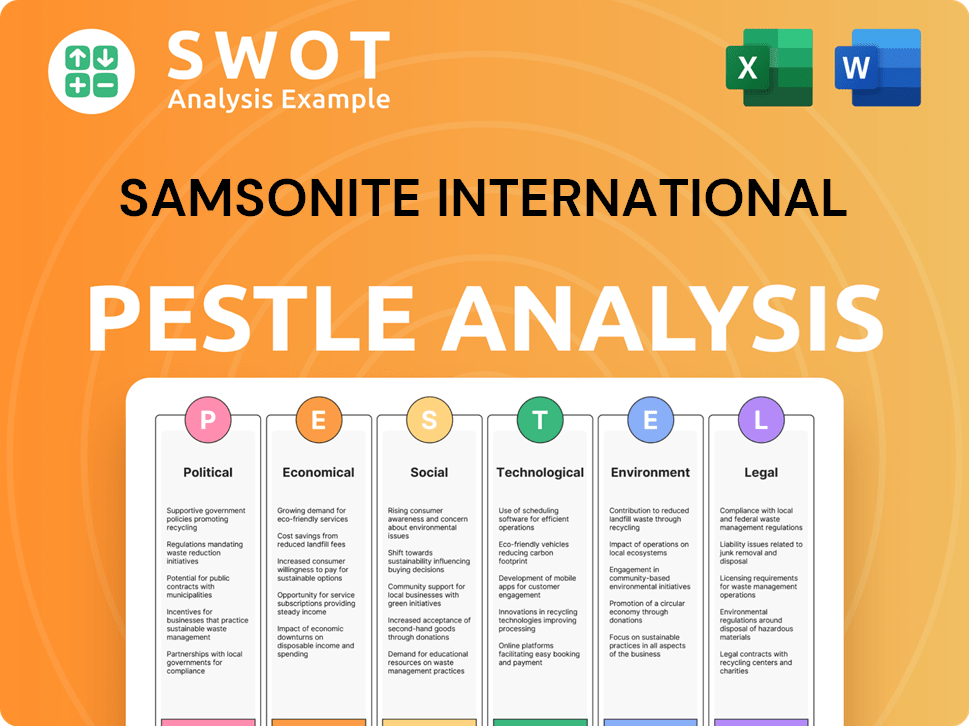
What are the key Milestones in Samsonite International history?
The brief history of Samsonite International is marked by significant milestones that have shaped its journey in the luggage and travel industry. From its early innovations to its global expansion, the company has consistently adapted to the evolving demands of travelers worldwide, establishing itself as a leading suitcase brand.
| Year | Milestone |
|---|---|
| 1910 | The company was founded in Denver, Colorado, by Jesse Shwayder. |
| 1941 | Introduced the 'Streamlite' suitcase, a design using vulcanized fiber, making it lighter and more modern. |
| 1960s | Formally adopted the 'Samsonite' name for the entire company. |
| 1969 | Introduced the first polypropylene suitcase, the 'Saturn,' offering enhanced durability and lightweight properties. |
| 1993 | Acquired American Tourister, expanding its product portfolio and market reach. |
| 2016 | Acquired Tumi for approximately $1.8 billion, significantly boosting its presence in the luxury segment. |
Throughout its history, Samsonite has been at the forefront of innovation in the luggage company sector. These innovations have not only improved the functionality of its products but also set new standards for the travel industry.
The 'Streamlite' suitcase, introduced in 1941, utilized vulcanized fiber, offering a lighter and more modern design compared to previous models. This innovation was a key step in making luggage more convenient for travelers.
The introduction of polypropylene suitcases, like the 'Saturn' in 1969, revolutionized luggage manufacturing. This material provided unprecedented durability and lightweight properties, enhancing the practicality of travel gear.
Samsonite has continually expanded its product lines to include a wide variety of luggage, travel accessories, and bags. This diversification allows the company to cater to a broad range of consumer needs and preferences.
The company integrates technology into its products, such as smart luggage with built-in tracking and charging capabilities. This integration meets the demands of tech-savvy travelers.
Samsonite is increasingly using sustainable materials in its products, responding to the growing consumer demand for eco-friendly options. This includes recycled materials and designs that minimize environmental impact.
The company focuses on innovative designs and aesthetics to attract consumers. This includes collaborations with designers and the introduction of stylish and functional products.
Despite its successes, Samsonite International has faced several challenges throughout its history. These challenges have required the company to adapt and innovate to maintain its market position.
Economic downturns have impacted consumer spending on travel goods, affecting the company's sales and profitability. The travel industry is sensitive to economic fluctuations, requiring strategic adjustments.
The luggage and travel industry is highly competitive, with numerous brands vying for market share. This competition necessitates continuous innovation and marketing efforts to stay ahead.
Changing consumer preferences and travel trends require the company to adapt its product offerings and marketing strategies. This includes responding to demands for sustainable products and tech-integrated luggage.
Global events, such as the COVID-19 pandemic, have led to supply chain disruptions, affecting the production and distribution of products. This has required the company to diversify its sourcing and logistics.
Currency fluctuations in international markets can impact the company's revenues and profitability. This necessitates careful financial management and hedging strategies.
The rise of e-commerce presents both opportunities and challenges, including the need to compete with online retailers and manage digital marketing effectively. The company must invest in its online presence and customer experience.
Samsonite International Business Model Canvas
- Complete 9-Block Business Model Canvas
- Effortlessly Communicate Your Business Strategy
- Investor-Ready BMC Format
- 100% Editable and Customizable
- Clear and Structured Layout
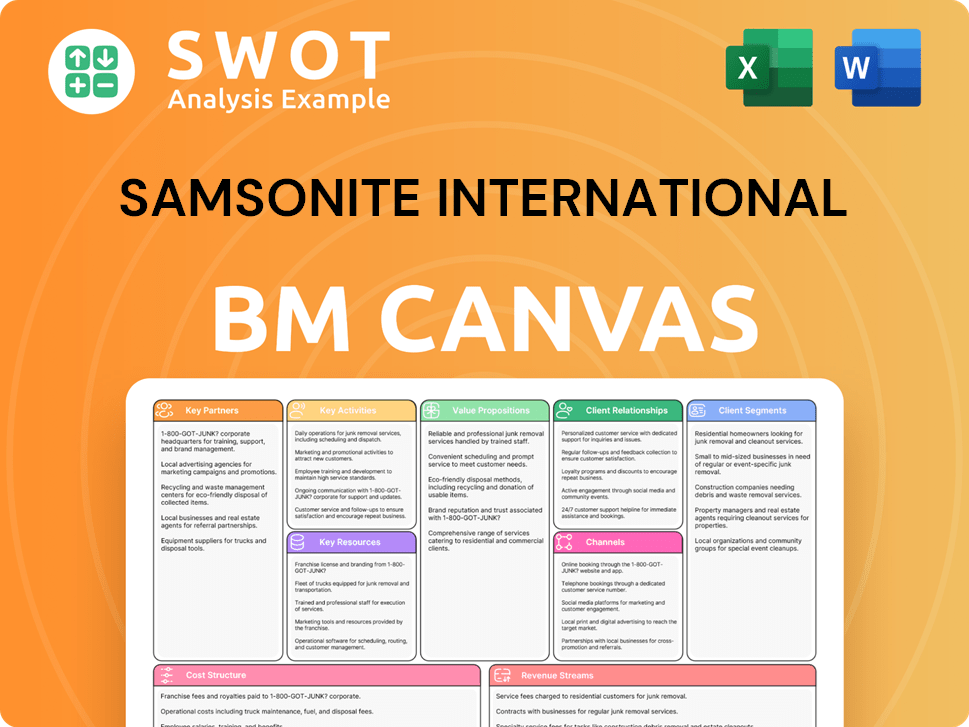
What is the Timeline of Key Events for Samsonite International?
The brief history of Samsonite, a leading luggage company, is a story of innovation and adaptation, beginning with its founding in 1910. Over the years, the Samsonite history has seen significant milestones, from pioneering materials to strategic acquisitions, shaping its position in the travel industry.
| Year | Key Event |
|---|---|
| 1910 | Jesse Shwayder founded the Shwayder Trunk Manufacturing Company in Denver, Colorado, marking the beginning of the Samsonite's early years. |
| 1941 | Introduction of the Streamlite suitcase, utilizing vulcanized fiber, showcased early product innovation. |
| 1966 | The company officially changed its name to Samsonite Corporation, solidifying its brand identity. |
| 1969 | Launch of the Saturn, the first polypropylene suitcase, demonstrated a commitment to advanced materials. |
| 1993 | Acquisition of American Tourister expanded its market reach. |
| 2005 | Samsonite delisted from NASDAQ and was acquired by CVC Capital Partners, reflecting financial restructuring. |
| 2011 | Samsonite International S.A. listed on the Hong Kong Stock Exchange, marking its global expansion. |
| 2016 | Acquisition of Tumi Holdings, Inc. for approximately $1.8 billion, strengthening its portfolio. |
| 2020 | Navigated challenges posed by the global pandemic and its impact on travel, adapting to market changes. |
| 2023-2024 | Focus on digital transformation, e-commerce growth, and sustainability initiatives, highlighting its current status. |
The company is investing heavily in enhancing its digital presence and e-commerce capabilities. This includes improving online shopping experiences and expanding its digital marketing efforts. Recent data indicates that online sales in the travel goods sector have increased by approximately 20% in the past year, reflecting shifting consumer preferences.
Sustainability is a key focus, with efforts to incorporate eco-friendly materials and sustainable manufacturing processes. This includes using recycled materials and reducing its carbon footprint. The global market for sustainable travel goods is projected to grow significantly, with an estimated 15% annual growth rate over the next five years.
Analysts predict continued growth in the travel goods market, driven by increasing global travel and tourism. The company is well-positioned to capitalize on this trend due to its strong brand portfolio and global distribution network. The travel goods market is expected to reach a value of over $50 billion by 2027.
The company's future outlook remains tied to its founding vision of providing durable and innovative travel solutions. It continues to adapt to the evolving demands of the modern traveler, with a focus on product innovation and design. Recent product innovations include smart luggage with integrated technology and enhanced security features.
Samsonite International Porter's Five Forces Analysis
- Covers All 5 Competitive Forces in Detail
- Structured for Consultants, Students, and Founders
- 100% Editable in Microsoft Word & Excel
- Instant Digital Download – Use Immediately
- Compatible with Mac & PC – Fully Unlocked
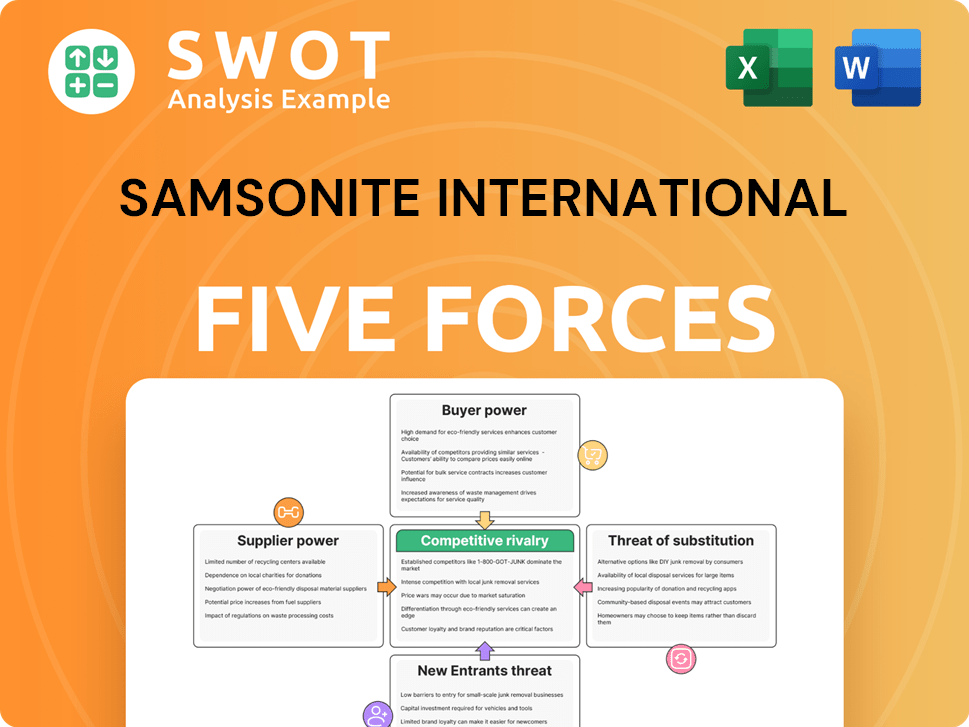
Related Blogs
- What is Competitive Landscape of Samsonite International Company?
- What is Growth Strategy and Future Prospects of Samsonite International Company?
- How Does Samsonite International Company Work?
- What is Sales and Marketing Strategy of Samsonite International Company?
- What is Brief History of Samsonite International Company?
- Who Owns Samsonite International Company?
- What is Customer Demographics and Target Market of Samsonite International Company?
Disclaimer
All information, articles, and product details provided on this website are for general informational and educational purposes only. We do not claim any ownership over, nor do we intend to infringe upon, any trademarks, copyrights, logos, brand names, or other intellectual property mentioned or depicted on this site. Such intellectual property remains the property of its respective owners, and any references here are made solely for identification or informational purposes, without implying any affiliation, endorsement, or partnership.
We make no representations or warranties, express or implied, regarding the accuracy, completeness, or suitability of any content or products presented. Nothing on this website should be construed as legal, tax, investment, financial, medical, or other professional advice. In addition, no part of this site—including articles or product references—constitutes a solicitation, recommendation, endorsement, advertisement, or offer to buy or sell any securities, franchises, or other financial instruments, particularly in jurisdictions where such activity would be unlawful.
All content is of a general nature and may not address the specific circumstances of any individual or entity. It is not a substitute for professional advice or services. Any actions you take based on the information provided here are strictly at your own risk. You accept full responsibility for any decisions or outcomes arising from your use of this website and agree to release us from any liability in connection with your use of, or reliance upon, the content or products found herein.